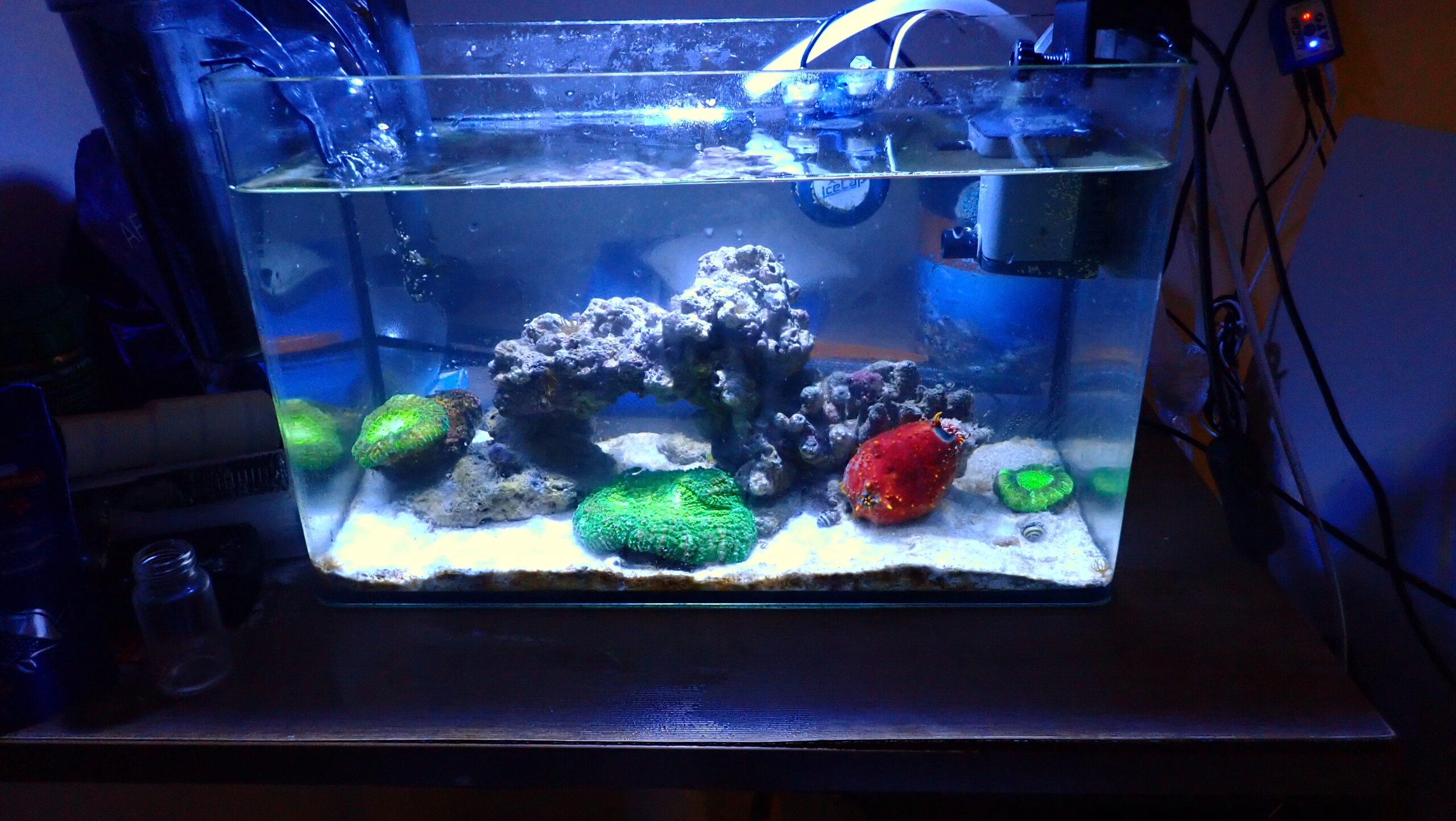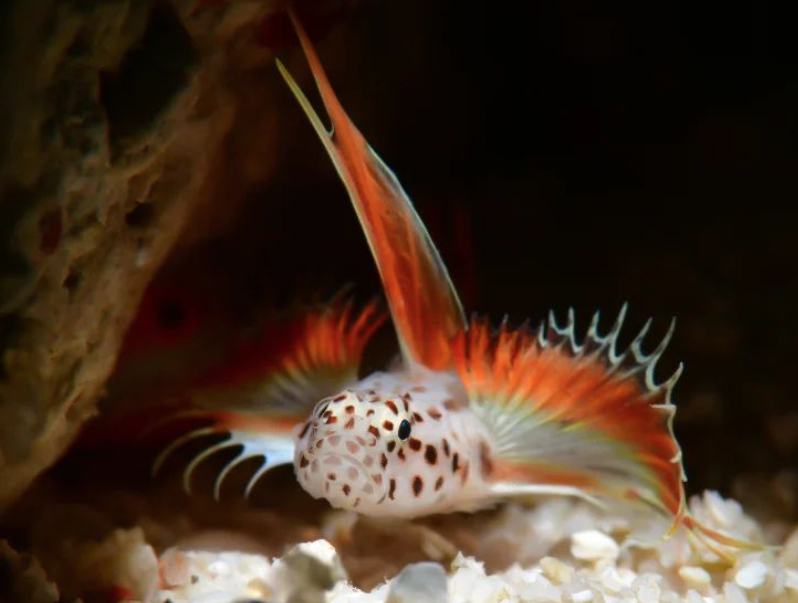Rarely available, expensive, yet beautiful with strikingly vibrant orange fins and charismatic behavior, the Greissinger Goby (Discordipinna griessingeri) can be a truly enjoyable addition for reef-keeping hobbyists who maintain suitable aquariums.
Native to the tropical Indo-Pacific and most commonly collected for the aquarium hobby in the Philippines, the Spikefin Goby (as it’s commonly referred to) and the entire Discordipinna genus, composed of only one other species (Discordipinna filamentosa), were identified and assigned Latin names less than 50 years ago.
Both the reason it wasn’t named until 1978 and the difficulty hobbyists encounter when attempting to locate an affordable specimen in a state of high health in the United States and Europe can be largely attributed to their diminutive size, with mature individuals attaining a mere 3-4 centimeters. However, maintaining these small, enchanting fish isn’t as difficult as some might assume, and, when housed in a tank designed in such a way that they can be fully appreciated, many would find them to be a truly delightful addition.
For the typical reef-keeping enthusiast who finds him or herself frequently spending hours peering into their unique slice of the ocean, the Greissinger Goby’s engaging flicking of its radiant fins almost appears to believe it’s trying to win first place in a pageant while hunting for food, would be a captivating sight to behold.

Behavior
While hobbyists have a wide variety of nano fish to choose from when planning a nano, or pico tank, the Spikefin Goby’s behavior should be kept in mind and even prioritized. In their native habitat, they’ve adopted a cryptic lifestyle as a primary form of defense due to their minute size in comparison to the majority of other reef-dwelling fishes.
Unlike many small gobies, this species has no symbiotic relationship with shrimp and does not burrow in the sand for protection. Greissinger Gobies are generally found in areas surrounded by various corals with copious amounts of rubble covering the sandbed where they can spend much of their time hidden within the tight crevices of rocks, corals, or among the rubble below, where they feel safe being out of sight of predators and difficult to corner in the event they are spotted.
In captive environments, such as home aquariums, they tend to seek the same type of shelter, regardless of whether they may be housed with aggressive or docile tankmates. As many hobbyists prefer pristine sandbeds for aesthetics instead of rubble, the gobies commonly seek tight crevices found in the rockwork or other well-hidden areas where they sense the same degree of safety as in their native habitat.
Therefore, it isn’t unusual to rarely catch a glimpse of them during the day, particularly when housed in large tanks with many hidden areas or if they feel as if they’re being watched. Because of this, smaller aquariums are generally better suited if the aquarist desires to view them during the day (which is quite a joy to behold). When maintained in a properly sized tank, it’s far more likely to have an opportunity to view them as they venture out of hiding while foraging for microfaunal invertebrates to prey on while they move about the sandbed or scoot themselves onto small rocks.
As a benthic (bottom-dwelling) species, they primarily search for food by scuttling around the sand and between corals and rocks instead of swimming, stopping periodically to eloquently flick their spikey, radiant orange fins in all directions. Though they maintain their shy demeanor and will quickly dart back into hiding if startled, the display of this peaceful, yet distinctive hunting style is starkly different from that of other nano fish and one cannot help but appreciate this unique “hunting dance”.
Though this is simply their natural behavior, it would almost appear as though the goby is attempting to charm its prey and lure it closer by putting on an intriguing show!
Considerations for the Chosen Aquarium
With cryptic behavior and petite size the maximum recommended volume of the aquarium for housing this species is no more than 20 gallons in order to have the pleasure of viewing the distinctively quirky behavior while hunting or simply appreciating its beauty. Even in a well-aquascaped 20-gallon tank, it would be less common to catch sight of the goby as many have discovered.
Nano tanks of 10 gallons are more than adequate for meeting requirements and are an ideal size as long as enough rock, corals, or other substrate is present to offer a sense of comfort and safety. Though many might have concerns regarding the presence of a sufficient population of microfaunal prey to sustain a fish not trained to feed on frozen or live foods, their appetite is far less than that of similarly sized fish such as small dragonets. In fact, even pico tanks can sustain them through dosing live phytoplankton to increase the population of prey such as copepods and amphipods.
If housed in an aquarium of the above size, it’s advisable to first establish the copepod and amphipod population prior to stocking the goby. This can be achieved fastest in tanks started with live rock harvested from the ocean (either natural ocean harvested live rock or maricultured live rock) due to the presence of a wide variety of hitchhiking microfaunal invertebrates which rapidly colonize the tank. If dry rock and sand are used, copepods can be introduced but the species must be taken into consideration.
Due to different rates of reproduction, preferences for different levels of salinity and temperature, varying food preferences, and behaviors among copepod species, it’s highly advisable to add multiple species such as Tisbe, Tigriopus, and Apocyclops copepods in order to establish diversity. Regardless of the chosen method, it’s crucial to supplement with phytoplankton in order to maintain a high population density in a pico tank housing any fish that relies on these organisms for food.

Aquarium Design and Potential Hazards
While choosing to stock a nano or pico tank with a Greissinger Goby makes a wonderful addition and is a great choice as it creates more frequent opportunities for viewing a cryptic species, there are additional aspects of the aquarium that should be taken into consideration. As with all our beloved watery friends, it’s imperative to prioritize the needs of the fish over our desire to enjoy them.
Ensure the goby feels comfortable in his new home by ensuring many crevices and other areas to hide are present and the tank isn’t overcrowded. While not absolutely necessary, maricultured or naturally harvested live rock confers the advantage of creating a more similar environment to natural reefs due to the natural crevices. However, one drawback of using this type of rock is the undesirable hitchhikers such as crabs, many of which take refuge in the same areas as the goby and can easily make a meal of the small fish if hungry.
In order to avoid this, it should be ensured that all potentially hazardous hitchhikers such as crabs of any species are removed before the goby is added. Additionally, it shouldn’t be forgotten that Greissinger Gobies dwell in the benthic zone. This requires rocks to be accessible from the sandbed to serve as places of refuge meaning tall, artistic arches branching mid-tank and rising high into the water column with minimal contact low in the tank are less desirable.
Artistic structures making room for corals are beautiful in small tanks and are perfectly fine, given there are plenty of accessible crevices and hide-outs as well. Lastly, it would not be advisable to house other species that share a common food source in a small tank, fish that may show territorial behavior (including certain breeds of clownfish), or species that are known to show aggression at any time.
However, other docile, peaceful fish such as the Pink-Streaked Wrasse (Pseudocheilinops ataenia) or Yellow Clown Goby (Gobiodon okinawae) would make fine tankmates given adequate space.
My Experience in Maintaining Spikefin Gobies
Fortunately, residing in Thailand has provided me the opportunity to acquire a healthy Greissinger Goby for far less than the prices generally commanded elsewhere. Although they’re rarely available, due to the greatly shortened supply chain the fish are imported while still in a state of high health.
As space is limited in my apartment and I was already maintaining two well-established tanks as well as one other, I decided to design my first 2.5-gallon pico tank with the Greissinger Goby serving as the sole inhabitant. Having always preferred the live rock available from a nearby shop which frequently received shipments directly from Indonesia collected a week or less before purchase, I chose a few pieces covered in gorgeous pink and purple coralline and to lay a thin bed of live sand on the bottom of the tank.
Due to the unrivaled freshness of the rock, it was teeming with life which included numerous species of hitchhiking copepods, amphipods, blue sponges, and other microfauna. Great care was taken while inspecting the rocks for crabs and other undesirable critters which were removed prior to the introduction of the goby. I immediately began dosing live phytoplankton nightly to grow and maintain the copepod population.
For a brief time, the tank remained fairly barren aside from several bumblebee snails (Engina sp.) and a few vibrant mini Scolys which added splashes of neon green, contrasting beautifully with the coralline algae covering the rocks. The equipment was minimal, consisting of only a small HOB filter on one side of the tank, fluorescent light clipped to the opposite side, a low-flow pump for gentle water movement, and an IceCap ATO to maintain stable parameters which would have otherwise fluctuated greatly due to evaporation.
Notified by the owner that the LFS would have 3-4 Greissinger Gobies arriving two weeks after assembling the tank, I placed a pre-order to minimize the time the fish might be subjected to a lack of food. Due to their size, it’s important to introduce them to an environment with a suitable food source as quickly as possible to avoid starvation. With this in mind, coupled with the fact that disease prevention wasn’t a priority for a tank housing only one fish, quarantine was skipped and the fish was introduced immediately after slow acclimation.
Though it is possible to train this and similar species to feed on prepared foods, I chose to maintain a natural, live food source by continuing to dose live phytoplankton nightly. Avoiding direct feeding not only simplified the maintenance of the tank but also aided in the avoidance of high nitrate and phosphate levels.
Wishing to continue this simple and effective strategy, a small sea apple was later added. As a filter feeder, nutritional requirements were easily met from the live mixture of phytoplankton species and the occasional pinch of coral foods such as Reef Roids.
Acknowledging that the tank had now reached its maximum carrying capacity and I had achieved my goal of a captivating species tank, I resisted the relatable urge to constantly tweak the now stable and thriving tank or modify the established maintenance schedule. From that point forward, there were no more additions aside from small, compatible corals such as mini Scolys of particular beauty.
Greissinger Gobies are ideal for small aquariums and are an excellent choice for a species tank in which they can be fully appreciated. Despite the high cost in many areas, few would find themselves regretting the purchase and instead soon find these enchanting fish to hold a special place in both their tank and heart. With a properly designed aquarium and care regimen, maintaining this charming species can be a truly rewarding and unforgettable experience!
About the author
Malcolm Gray Levison is an avid diver, reef-keeping hobbyist, and dive photographer who takes great joy in sharing his experiences with others through his writing. He also possesses a true passion for studying the biology and ecology of coral reefs and desires to contribute to the conservation of these fragile ecosystems.

Main image credit https://www.instagram.com/asuka.kota_4dk/



